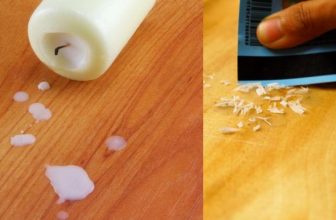How to Prevent Soot From Candles
When it comes to enjoying the warm glow and comforting scent of candles, soot can often become an unwelcome companion. Soot not only diminishes the aesthetic appeal of your candles but can also pose health risks and cause damage to your home. Understanding how to prevent soot formation is crucial for maintaining a clean and inviting environment.

In this guide on how to prevent soot from candles, we’ll explore effective strategies to minimize soot production while still enjoying the beautiful ambiance that candles provide.
What is Soot and Why Does it Form?
Soot is the black residue that forms when candles are burned. It is composed of tiny particles of carbon, tar, oils, and other impurities released as a byproduct of incomplete combustion. The amount of soot produced by a candle depends on various factors such as the type of wick, wax, and fragrance used. A common misconception is that only cheap or low-quality candles produce soot; however, even high-quality candles can produce soot if not burned correctly.
It’s essential to understand why soot forms to effectively prevent it from happening. Soot is a natural byproduct of burning anything, including candles.
Needed Materials
Candles With Cotton Wicks:
- Candles with cotton wicks tend to produce less soot compared to those with other types of wicks.
- Beeswax, soy wax, and vegetable-based candles are known to have a lower soot production compared to paraffin wax candles.
- Look for candles labeled as “low-soot” or “clean-burning.”
Candle Trimmers:
- Trim the wick to about ¼ inch before each use.
- This prevents the wick from becoming too long and producing excess soot.
Draft-Free Environment:
- Avoid burning candles in drafty areas as this can cause uneven burning and result in soot formation.
- Keep the candle away from open windows, fans, or air vents.
Proper Burning Time:
- Burn candles for at least one hour per inch of its diameter to ensure a clean burn.
- This allows the wax to melt evenly, preventing tunneling (uneven burning) that can lead to soot production.
8 Step-by-step Guidelines on How to Prevent Soot From Candles
Step 1: Choose Candles Wisely
Selecting the right candles is the first step in preventing soot production. Opt for candles made from natural waxes such as beeswax, soy wax, or palm wax, as these generally burn cleaner than paraffin wax candles. Additionally, ensure that the candles feature high-quality cotton or wood wicks, which promote a more even burn and reduce the likelihood of soot.

Look for candles specifically labelled as “low-soot” or “clean-burning,” and pay attention to the fragrances used, as synthetic fragrances can sometimes contribute to excessive soot. By making informed choices, you can enjoy the beauty of candles while minimizing soot formation.
Step 2: Trim the Wicks
As mentioned earlier, keeping your wick trimmed to about ¼ inch before each use is crucial in preventing soot. Use scissors or a specialized wick trimmer to ensure the correct length. Trimming the wick also helps control how quickly the candle burns, leading to a longer-lasting and cleaner burn.
You may also notice that some candles have self-trimming wicks, which curl inwards as they burn, preventing excessive soot production. However, it’s always best to trim the wick yourself for maximum effectiveness.
Step 3: Burn Candles for a Sufficient Amount of Time
As mentioned earlier, burning candles for at least one hour per inch of diameter is crucial in preventing soot formation. This allows the wax to melt evenly and prevents tunneling, where the candle burns down the middle, leaving unused wax on the sides. Tunneling can result in an uneven burn and excess soot production.
It’s also essential to avoid burning candles for an extended period of time, as this can lead to overheating and cause the wick to produce more soot. Avoid burning candles longer than four hours at a time.
Step 4: Keep Candles in a Draft-Free Environment
As mentioned earlier, burning candles in drafty areas can cause uneven burning and soot production. It’s crucial to keep your candle away from open windows, fans, or air vents that may create drafts. Ensure that the area where you burn your candle is still and free from any airflow.

The ideal environment for burning candles is a warm, still room. Avoid placing candles near air conditioners or heating vents.
Step 5: Keep the Candle Clean
Over time, dust and debris can accumulate on the surface of your candle, hindering its ability to burn cleanly. Before lighting your candle, use a soft cloth or tissue to gently wipe any visible dirt or dust from the surface of the candle. This will help ensure a clean burn and minimize soot production.
It’s also essential to keep the area around the candle clean. Any debris or dust that falls into the melted wax can cause it to burn unevenly and produce excess soot.
Step 6: Keep Candles in an Upright Position
When lighting a candle, make sure it is sitting upright to ensure an even burn. If a candle is tilted or leaning, it may result in an uneven burn, causing excess soot production.
If you notice your candle starting to tilt as it burns down, gently straighten it out with a skewer or wick dipper.
Step 7: Use Candle Accessories
Using accessories such as snuffers, wick trimmers, and wick dippers can also help prevent soot production. Snuffers are designed to extinguish the flame without producing any smoke or soot, while wick trimmers and dippers help maintain a proper wick length for a cleaner burn.
Using these tools correctly can contribute to minimizing soot in your candle-burning experience.
Step 8: Burn Candles Responsibly
Finally, always remember to practice responsible candle-burning habits. Never leave a burning candle unattended, and keep it out of reach from children or pets. Always burn candles on a stable, heat-resistant surface and away from any flammable materials.

Additionally, make sure to extinguish the flame completely before leaving the room or going to bed.
By following these guidelines on how to prevent soot from candles and using proper burning techniques, you can enjoy the warmth and ambiance of candles without worrying about excessive soot production. Remember to choose high-quality candles with cotton wicks, trim the wick before each use, burn for a sufficient amount of time, keep in a draft-free environment, keep clean, use accessories when necessary, and practice responsible burning habits. Happy candle-burning!
Tips to Prevent Soot from Candles
Choose High-Quality Candles:
As mentioned earlier, the quality of a candle plays a significant role in its soot production. Opt for candles made from natural materials such as soy wax instead of paraffin wax. Natural waxes tend to burn cleaner and produce less soot.
Additionally, look for candles that use high-quality cotton or wood wicks, which help promote an even burn and reduce the likelihood of soot.
Burn Candles in Glass Jars:
Glass jars can act as a barrier between the burning flame and any potential drafts in the environment. This helps prevent uneven burning and excess soot production.
Choosing candles in glass jars also adds an extra layer of safety, as the glass can contain any wax spills or protect against accidental contact with flammable materials.
Consider Using Candle Warmers:
Candle warmers are devices that melt the candle wax without producing a flame. They provide a safe alternative to traditional candle burning and reduce the likelihood of soot formation.
They also allow you to enjoy your favorite candle fragrances without worrying about any potential hazards.
With these additional tips, you can enhance your candle-burning experience and minimize the likelihood of soot production. Remember to always prioritize safety and make informed choices when selecting candles.
Frequently Asked Questions
Q: Why Does My Candle Produce Soot?
A: There are several factors that can contribute to soot production, such as low-quality materials, drafty environments, and improper burning techniques. It’s essential to choose high-quality candles, burn them for a sufficient amount of time, and keep them in a draft-free environment to prevent soot formation.

Q: Can I Use Any Type of Candle?
A: It’s best to use candles made from natural materials such as soy wax or beeswax instead of paraffin wax. These natural waxes tend to burn cleaner and produce less soot. Additionally, always opt for candles with cotton or wood wicks for a cleaner burn.
Q: How Often Should I Trim the Wick?
A: It’s crucial to trim the wick before each use to ensure a proper length and prevent excess soot production. However, it’s also essential to monitor the wick as it burns and trim it if necessary to maintain a proper length.
Q: Is Soot Dangerous?
A: While soot is not considered harmful in small amounts, excessive soot production can be an indication of potential health hazards such as air pollutants. It’s best to take preventative measures by following proper burning techniques and choosing high-quality candles to minimize soot production. Lastly, always prioritize safety and proper candle care for a cleaner, safer candle-burning experience.
Conclusion
In summary, enjoying candles can significantly enhance the atmosphere of any room, but it’s essential to be mindful of soot production. By choosing high-quality materials, maintaining proper burning techniques, and employing the right accessories, you can create a cleaner and safer candle experience. Remember to keep your candles in a suitable environment and practice responsible habits while burning them.
By following these guidelines on how to prevent soot from candles, you can bask in the warm glow and delightful fragrances of candles while minimizing any unwanted soot, ultimately allowing for a more pleasant environment in your home. Happy candle-burning!




